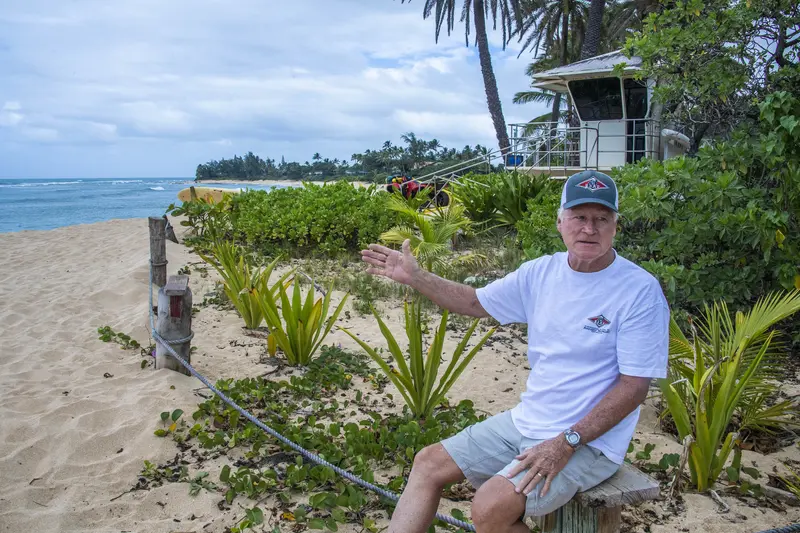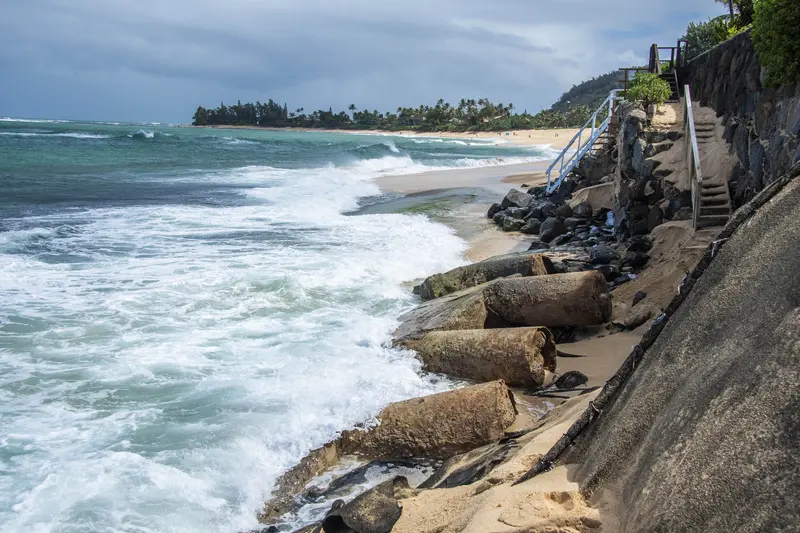This article was produced for ProPublica’s Local Reporting Network in partnership with the Honolulu Star-Advertiser, which was a member of the ProPublica Local Reporting Network in 2020. Sign up for Dispatches to get stories like this one as soon as they are published.
On a gusty Saturday morning, local residents and visitors lounged along Oahu’s picturesque Sunset Beach, breathing the thick, salty air and swimming in the deep blue and turquoise waters. Two women strolled along the beach, where waves glided up the deep deposits of golden sand, before stopping short and retreating.
Amid the waves were tangled mounds of thick, black fabric, sandbags the size of large tree trunks, boulders and wood planks with protruding screws — the components of the makeshift seawalls that property owners have built along the public beach to protect their homes from being sucked into the ocean. The large piles that front about half a dozen homes block residents and visitors from walking along one of the world’s most famous stretches of sand.
“It looks like a trash heap,” said Ocean Lemus, a beachgoer who stopped to stare at the mess. “Not something you would assume to find on Sunset Beach, which is the premier surf spot.”
Indeed, it’s not supposed to be there. But the people responsible are some of the most well known in the community, and with state permissions to dump these elements expiring, Hawaii authorities are now poised to crack down.
In 2018, the state Department of Land and Natural Resources gave property owners along this span of North Shore coastline, which fronts famed surf breaks known as Monster Mush and Kammies, temporary permission to install emergency “burritos,” long, sand-filled tubes covered by heavy fabric that create a hard barrier against ocean waves, on the public beach fronting their properties.
Such protections are supposed to be forbidden under state law, given the environmental damage that the makeshift structures can wreak on public beaches. When waves slam up against a hardened shoreline, they claw away at the sand, causing beaches to disappear. Oahu has already lost about one-quarter of its beaches to shoreline hardening over the last century, and scientists warn that figure could rise to 40% by 2050.
But, as the Honolulu Star-Advertiser and ProPublica reported last year, DLNR deemed the homes “imminently threatened” and allowed the homeowners to install the protections on a temporary basis with the condition they be removed in three years, or even sooner if there were signs they were damaging the beach.
The homeowners, however, have refused to remove the protections, many of which had their authorizations expire between July and September of this year. These property owners are among dozens throughout the islands who have been allowed to install temporary sandbags and other protections.
Many of the beneficiaries are owners of multimillion-dollar homes along some of the most prized beaches in the state, including famous surfer Fred Patacchia, whose permit expires later this month. (Patacchia did not reply to a request for comment.)
Now, DLNR officials seem to be trying to rein in the protections, telling the news organizations that the temporary measures along North Shore areas such as Kammies have “led to obvious degradation of the public beach resource.”
DLNR officials, including Board of Land and Natural Resources Chairperson Suzanne Case, who oversees the department, did not respond to interview requests. But in written responses, the department’s Office of Conservation and Coastal Lands said that about 70 coastal properties throughout the state have expired emergency permits and those owners have or will be receiving letters of “alleged noncompliance,” along with requests for information about how they intend to “correct the situation” and their “plans moving forward in the long term.”
The coastal office, which previously said it was revising its rules in response to the Star-Advertiser/ProPublica investigation, said it is requiring homeowners to prove that a “bona fide planning effort” is underway, including employing “professional planners, engineers, or consultants to develop and implement a long-term solution whether it involves relocation or abandonment, beach restoration, or some other form of shoreline management.”
OCCL also said before any potential time extensions are approved, property owners may be required to provide a surety bond or other financial assurance to ensure the temporary protections are ultimately removed. Officials didn’t specify how long of an extension may be granted to the homeowners.
Under state law, officials can fine property owners $15,000 a day for unauthorized structures that remain on the beach, though they have yet to take that step against homeowners with expired permits. Nevertheless, the uptick in oversight represents a stark shift in approach for Hawaii’s coastal officials.
As the Star-Advertiser and ProPublica reported last year, temporary sandbags and burrito systems are rarely removed from public beaches when their permissions are set to expire, in large part because state officials have repeatedly granted homeowners extensions or don’t enforce their own deadlines. In addition, the state has often granted after-the-fact approval for structures that were built illegally.
In at least one case where coastal officials rejected an illegal barrier, they did not force its removal. In 2018, Kelly Slater, an 11-time world surfing champion who lives on Ehukai Beach by the world-famous Banzai Pipeline surf break, illegally installed a barrier made out of thick fabric. He was fined just $2,000. DLNR told the Star-Advertiser and ProPublica this month that “unauthorized land uses continue to exist” in front of Slater’s property and the department is “attempting to get the landowner to comply.” Slater, who did not respond to a request for comment, previously told the news organizations that without the sandbags people “would have lost properties outright.”
Asked why authorities hadn’t yet forced North Shore homeowners to remove the burritos with expired permits, OCCL said that many of the homes remain imminently threatened and that property owners have a right to due process. Officials have also said that they’re concerned about potential public safety hazards created by homes that could fall into the ocean.
“We understand that many of these homeowners are in a very stressful and challenging situation,” wrote DLNR’s Office of Conservation and Coastal Lands in response to queries about the North Shore burritos.
Many of the North Shore homeowners declined to answer or didn’t respond to requests for comment. But William Kernot, an owner of one of the homes that front the Kammies surf break, confirmed he received a letter from DLNR.
Kernot acknowledged his burrito system “looks terrible” but maintained it wasn’t harming the beach, even though it’s blocking the public shoreline. He said DLNR should approve a seawall for his property to improve the aesthetics of the coastline.
Coastal experts say engineering a seawall along this stretch, which isn’t permitted under state law, would be extremely difficult because the base would have to be excessively wide and deep in order to be stable.
“It would take over the whole beach,” said Dolan Eversole, a coastal geologist with the University of Hawaii Sea Grant College Program, indicating the much wider beach that builds up there during the winter months.
“If we desire beaches on the North Shore, we are going to have to get out of the way,” Eversole said.
Meanwhile, Randy Rarick, a well-known surfer and surf promoter who has lived along Sunset Beach for 50 years, said he is already seeing damage to this stretch of coastline from sea-level rise and the burritos.

In the wintertime, western swells typically deposit large amounts of sand to the east of the homes along Kammies, replenishing the long stretch of Sunset Beach. But Rarick said the burritos are blocking this from occurring, causing the sand to be depleted, a sign the burrito systems could contribute to a domino effect of beach loss along the coastline.
Rarick said backwash from the waves hitting this stretch of coastline hardened with sandbags, tarps and boulders is also disrupting the famous surf breaks.
“I feel really sorry for the homeowners,” Rarick said, “but sea-level rise is upon us.”


















